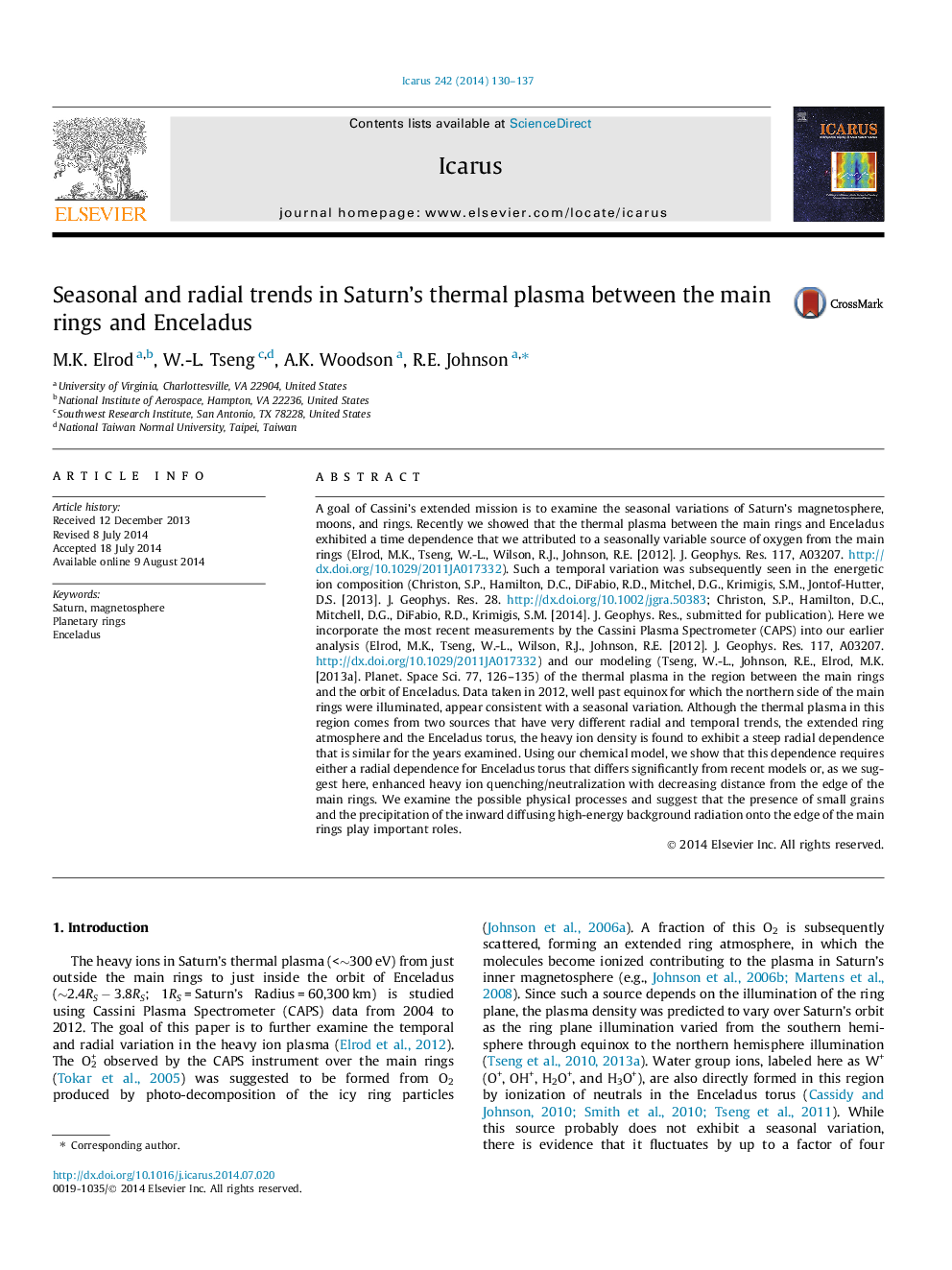| کد مقاله | کد نشریه | سال انتشار | مقاله انگلیسی | نسخه تمام متن |
|---|---|---|---|---|
| 8137601 | 1523548 | 2014 | 8 صفحه PDF | دانلود رایگان |
عنوان انگلیسی مقاله ISI
Seasonal and radial trends in Saturn's thermal plasma between the main rings and Enceladus
ترجمه فارسی عنوان
روند فصلی و شعاعی پلاسما حرارتی زحل در بین حلقه های اصلی و انسلادوس
دانلود مقاله + سفارش ترجمه
دانلود مقاله ISI انگلیسی
رایگان برای ایرانیان
کلمات کلیدی
زحل، مغناطیسفر، حلقه های سیاره ای، انسلادوس،
موضوعات مرتبط
مهندسی و علوم پایه
علوم زمین و سیارات
علوم فضا و نجوم
چکیده انگلیسی
A goal of Cassini's extended mission is to examine the seasonal variations of Saturn's magnetosphere, moons, and rings. Recently we showed that the thermal plasma between the main rings and Enceladus exhibited a time dependence that we attributed to a seasonally variable source of oxygen from the main rings (Elrod, M.K., Tseng, W.-L., Wilson, R.J., Johnson, R.E. [2012]. J. Geophys. Res. 117, A03207. http://dx.doi.org/10.1029/2011JA017332). Such a temporal variation was subsequently seen in the energetic ion composition (Christon, S.P., Hamilton, D.C., DiFabio, R.D., Mitchel, D.G., Krimigis, S.M., Jontof-Hutter, D.S. [2013]. J. Geophys. Res. 28. http://dx.doi.org/10.1002/jgra.50383; Christon, S.P., Hamilton, D.C., Mitchell, D.G., DiFabio, R.D., Krimigis, S.M. [2014]. J. Geophys. Res., submitted for publication). Here we incorporate the most recent measurements by the Cassini Plasma Spectrometer (CAPS) into our earlier analysis (Elrod, M.K., Tseng, W.-L., Wilson, R.J., Johnson, R.E. [2012]. J. Geophys. Res. 117, A03207. http://dx.doi.org/10.1029/2011JA017332) and our modeling (Tseng, W.-L., Johnson, R.E., Elrod, M.K. [2013a]. Planet. Space Sci. 77, 126-135) of the thermal plasma in the region between the main rings and the orbit of Enceladus. Data taken in 2012, well past equinox for which the northern side of the main rings were illuminated, appear consistent with a seasonal variation. Although the thermal plasma in this region comes from two sources that have very different radial and temporal trends, the extended ring atmosphere and the Enceladus torus, the heavy ion density is found to exhibit a steep radial dependence that is similar for the years examined. Using our chemical model, we show that this dependence requires either a radial dependence for Enceladus torus that differs significantly from recent models or, as we suggest here, enhanced heavy ion quenching/neutralization with decreasing distance from the edge of the main rings. We examine the possible physical processes and suggest that the presence of small grains and the precipitation of the inward diffusing high-energy background radiation onto the edge of the main rings play important roles.
ناشر
Database: Elsevier - ScienceDirect (ساینس دایرکت)
Journal: Icarus - Volume 242, 1 November 2014, Pages 130-137
Journal: Icarus - Volume 242, 1 November 2014, Pages 130-137
نویسندگان
M.K. Elrod, W.-L. Tseng, A.K. Woodson, R.E. Johnson,
